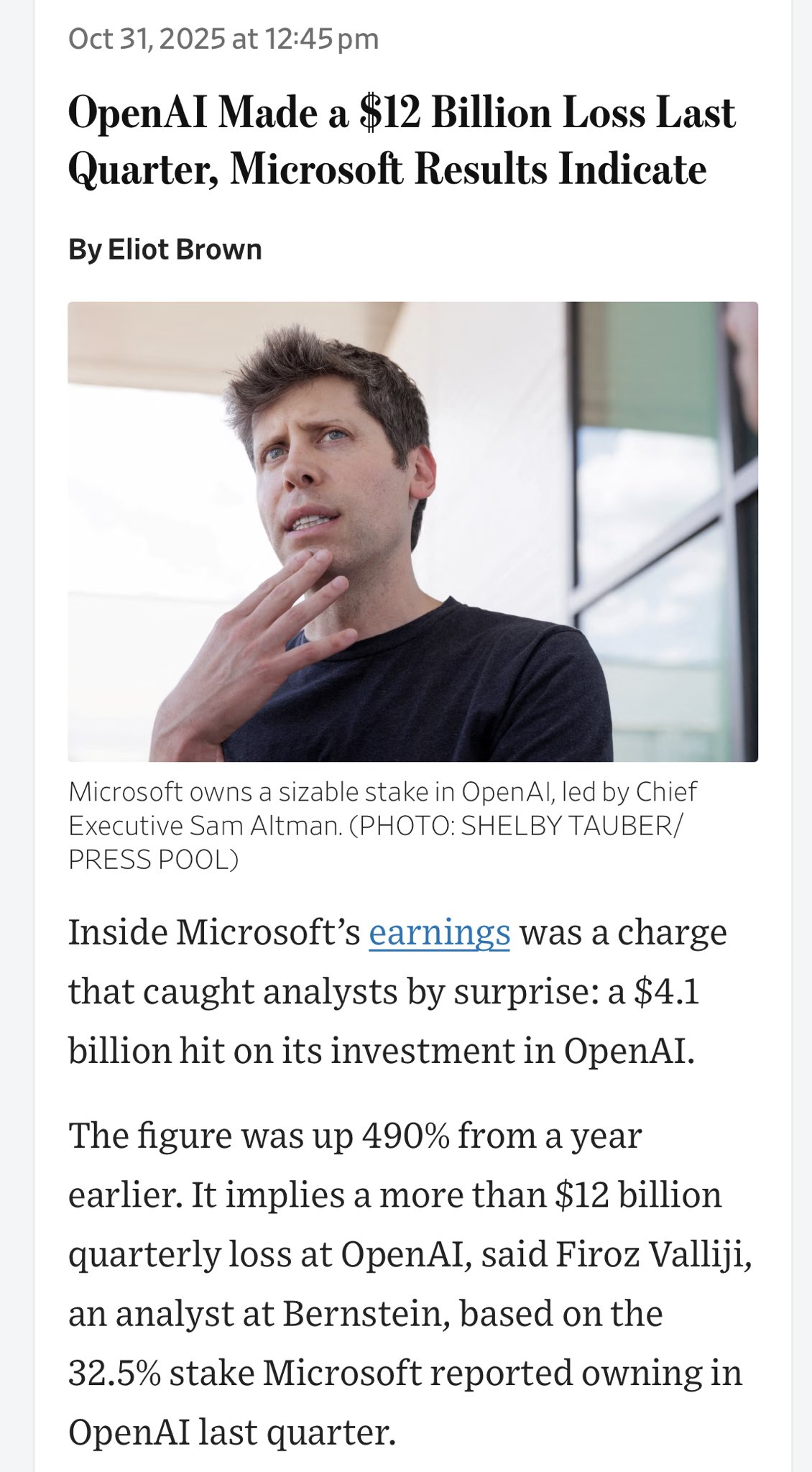OpenAI soll laut einem Bericht von Microsoft im Quartal 12 Milliarden Verlust gemacht haben.
Das ist heftig.
Zum Vergleich soll der Umsatz im der ersten Jahreshälfte nur 4.3 Milliarden betragen haben, das wären pro Quartal gerade einmal 2 Milliarden bei 12 Milliarden Verlust.
Andererseits könnte OpenAI vielleicht mit einer Versechsfachung oder Verzehnfachung des Umsatzes profitabel werden, je nachdem wie hoch die Strom- und Betriebskosten pro zusätzlichem Kunden sind. Umsatz ist ja nicht gleich Gewinn.
Dazu kommen noch erhebliche Investitionskosten von mehreren Hundert Milliarden Euro in den nächsten Jahren in neue KI-Rechenzentren. Davon profitiert hauptsächlich Nvidia und die Energiewirtschaft.
Nividia hat kürzlich auch 100 Milliarden in OpenAI investiert, damit OpenAI wieder mehr Chips von Nvidia kaufen kann. Manche sehen diesen Deal als Circle-Jerk, der ebenfalls nicht nachhaltig sein kann.
Nvidia hat eine Marketcap von über 5 Billionen und ist das wertvollste Unternehmen. Microsoft und Big Tech haben ebenfalls von dem KI-Boom profitiert.
Geld wäre also im Moment genug vorhanden, das verbrannt werden kann, aber nachhaltig ist es nicht.
Die Frage ist, wie viel User bereit sind für KIs zu bezahlen, welchen Nutzen diese bieten und welche Hardware man in Zukunft dafür benötigen wird.
Ein Trend, der sich in der Open-Source-Szene abzeichnet, ist, dass man durch Software- und Modell-Optimierungen mit immer weniger Hardware immer mehr machen kann. Vielleicht werden auch einmal Smartphone-Chips in der Lage sein, kleinere, aber leistungsfähige KI-Modelle lokal zu betreiben.
Bei diesen Investitionen in diesen Größenordnungen schwingt auch immer die Hoffnung auf AGI, das zukünftige Potential mit, ob AGI in nur wenigen Jahren erreichbar ist. Was ist, wenn die derzeitigen Modelle aber eher stagnieren, und nicht so leistungsfähig werden, wie erhofft und AGI doch noch mindestens 5-10 Jahre entfernt ist?
Was meint ihr? Wie lange kann OpenAI mit einem derart großen Verlust weitermachen? Wann platzt die KI-Bubble?
OpenAI Made a $12 Billion Loss Last Quarter, Microsoft Results Indicate

Source: https://www.wsj.com/livecoverage/stock-market-today-dow-sp-500-nasdaq-10-31-2025/card/openai-made-a-12-billion-loss-last-quarter-microsoft-results-indicate-e71BLjJA0e2XBthQZA5X
https://x.com/PeterBerezinBCA/status/1985050061273743555
https://x.com/i_am_fabs/status/1984355866276216861
OpenAI generates $4.3 billion in revenue in first half of 2025, the Information reports
https://www.reuters.com/technology/openais-first-half-revenue-rises-16-about-43-billion-information-reports-2025-09-30/
English
According to a report by Microsoft, OpenAI is said to have made a loss of $12 billion in the quarter.
That's huge.
By way of comparison, revenue in the first half of the year is said to have been only $4.3 billion, which would be just $2 billion per quarter with a loss of $12 billion.
On the other hand, OpenAI could perhaps become profitable by increasing its revenue sixfold or tenfold, depending on how high the electricity and operating costs per additional customer are. Revenue does not equal profit, after all.
Added to this are considerable investment costs of several hundred billion dollars in new AI data centers over the next few years. This mainly benefits Nvidia and the energy industry.
Nvidia recently invested $100 billion in OpenAI so that OpenAI can buy more chips from Nvidia. Some see this deal as a circle jerk that is also unsustainable.
Nvidia reached a market cap of over $5 trillion and is the most valuable company. Microsoft and Big Tech have also benefited from the AI boom.
So there would be enough money available to burn at the moment, but it is not sustainable.
The question is how much users are willing to pay for AI, what benefits it offers, and what hardware will be needed for it in the future.
One trend emerging in the open source scene is that software and model optimizations are making it possible to do more and more with less and less hardware. Perhaps smartphone chips will one day be able to run smaller but powerful AI models locally as well.
With investments of this magnitude, there is always the hope that AGI will be achievable in just a few years. But what if the current models stagnate and do not become as powerful as hoped, and AGI is still at least 5-10 years away?
What do you think? How long can OpenAI continue with such a large loss? When will the AI bubble burst?